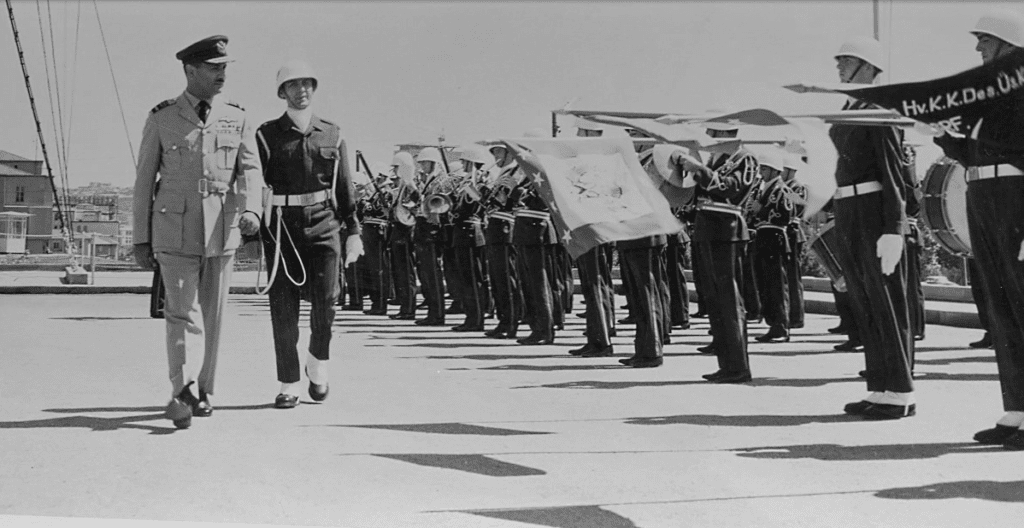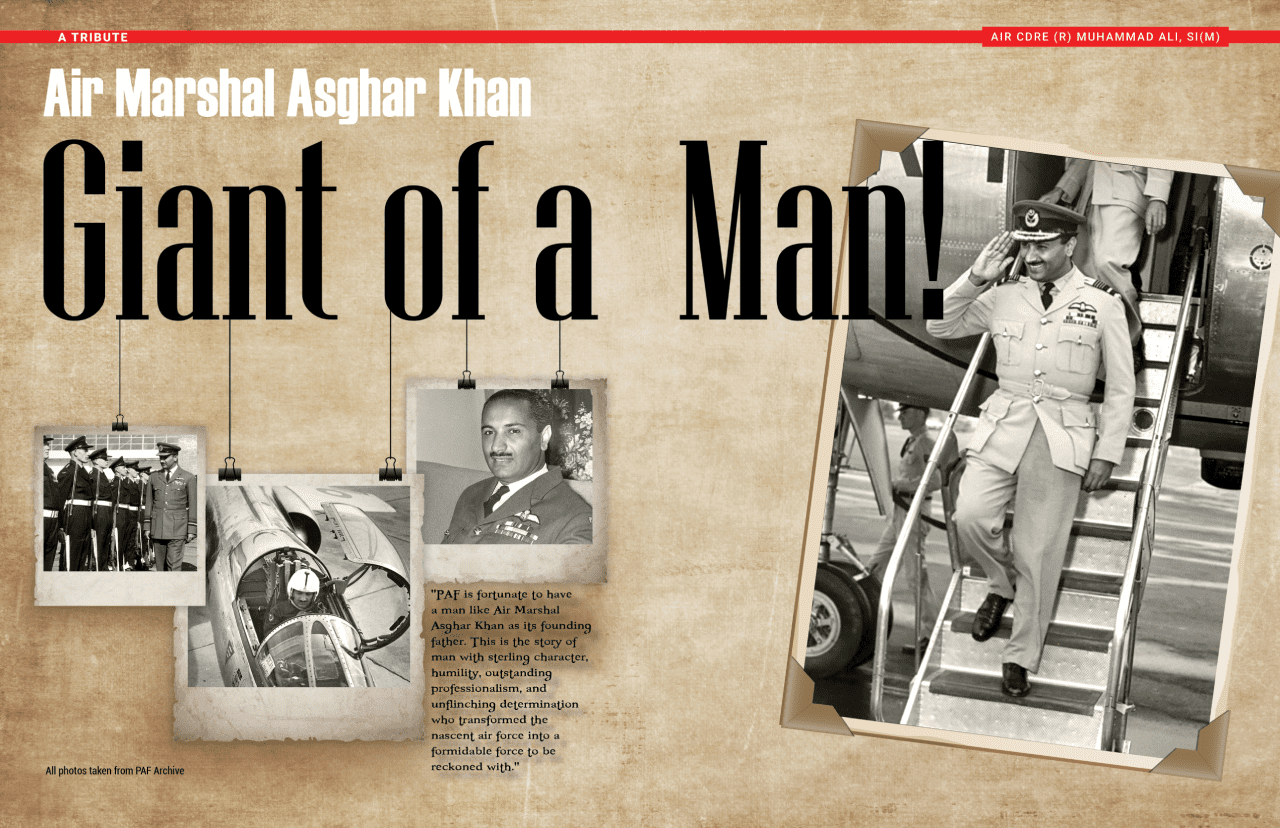In 2014, I was tasked by the then Chief of the Air Staff, Air Chief Marshal Tahir Rafique Butt to make a tribute documentary about retired Air Marshal Asghar Khan. I felt honored to have been given an opportunity to meet with someone who not only contributed towards military excellence, but also served for the cause of pacifism, peace, and human rights in the country after his retirement. Instead of approaching him directly, I set about preparing for the interview by speaking to people who had served with him, or knew him otherwise. The one thing that came up throughout these meetings was Asghar Khan’s non-indulgence in self-praise and reticence about interviews that glorified him. I was told that he’s a man of few words who believed in action rather than speech. Armed with this insight, I called his residence and spoke to Begum Asghar Khan. She was warm, cordial, and cautioned me about this kind of interview not being a norm for Asghar Khan.
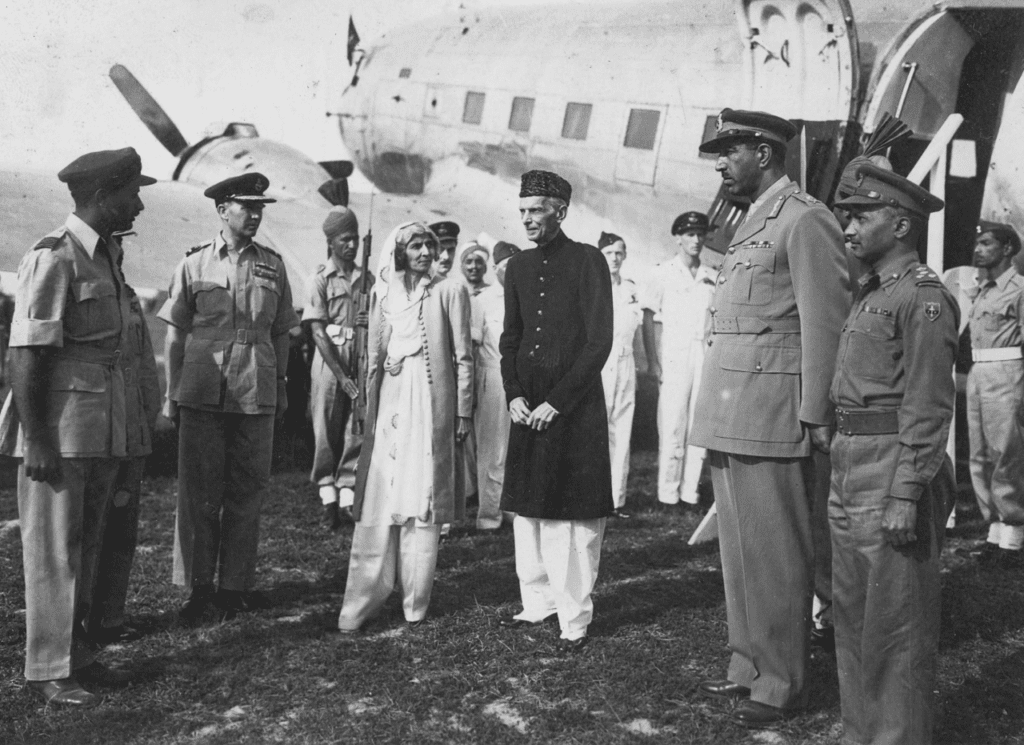
I vividly remember, it was a cold November morning when I turned up along with camera crew, half an hour before the appointed time, careful not to be late. I was ushered in, and the Begum Asghar Khan asked us if we would like some refreshments while we waited for the exact time of the meeting. At 1000 hrs sharp, we followed her into a study where the 90-year-old sat, ruddy in complexion, not a hair out of place. After the pleasantries had been exchanged, he asked me about my work and wondered why I would spend time on this when I could be utilizing it on something more productive. He surmised that since there wasn’t really much to tell, we should wrap up the interview in 15 minutes. I looked down at my meticulously prepared questionnaire, and wondered how I could finish my planned interview in such a short period. Nonetheless, I asked the camera crew to begin rolling. Seven and a half minutes into the interview, he brought my attention to the time elapsed and I knew that my questions had to be precise, and few. So far, he had tossed cold water at me. He had brushed off compliments, praises – from being the first Royal Indian Air Force officer to pilot the first fighter jet Gloster Meteor, to being the first and youngest Air Chief of air force in the military, to his contributions towards the excellence of PAF operations. “Anyone in my position would have done what I did. There was nothing extraordinary about me, and I deserve no praise,” he asserted. For the remainder of the time, every feat I asked him about, every stance that he took, he matter-of-factly responded that anyone in his stead would have done the same. I asked him if there was something he would like to say to the youth of PAF, the young boys; he said that they should do everything for Pakistan. If they are fighter pilots, they should love their profession, love flying, they should spend most of their time in their cockpits, and even those engaged otherwise, the priority for them should always be Pakistan.
Once the camera stopped rolling, I requested access to his library, his photos – the archive. As a true gentleman, he told me that he will get back to me once he has conferred with the Begum Sahiba. I was asked back on a Sunday morning to an admirable library in the house. The albums were housed here, long and well organized. There was an impressive collection of books, some written by the Air Marshal himself. Armed with a scanner, I stayed for the two allotted hours, curating the precious years of history in that room which enabled me to educate myself about the great leader, who truly was a Giant of a Man!
Early Days
Mohammad Asghar Khan was born to a military family on the 17th of January 1921. Brig Rahmatullah Khan, the father of Asghar Khan served in the Jammu and Kashmir Rifles of the British Indian Army and took part in WW2 in East Africa. Asghar Khan was the second amongst eleven children. His elder brother, Brig Aslam Khan, was a famous officer of Pakistan Army who earned his reputation as the “Legend of Baltistan” after his participation in first war with India in 1947-48.
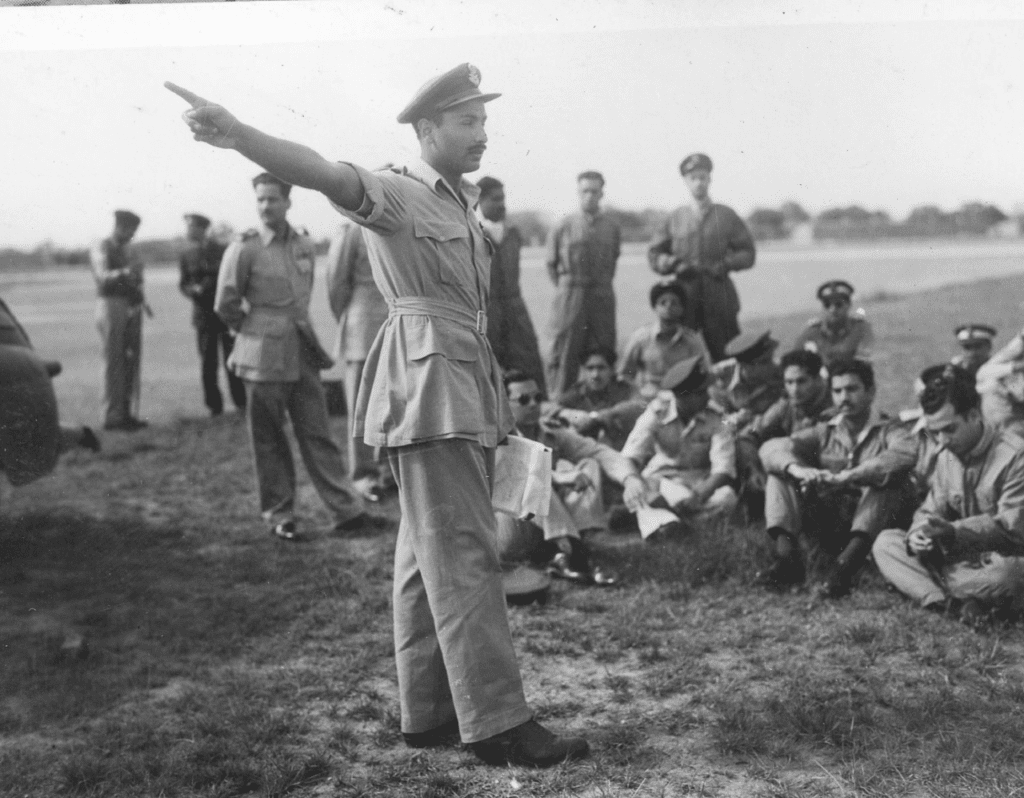
Asghar Khan joined Aitchison College for his earlier education and was later enrolled in the Prince of Wales’s Royal Indian Military College, Dehra Dun in 1933. He secured his matriculation in 1939. He appeared in the selection exam for Indian Military Academy. Only twelve candidates from entire sub-content passed the difficult test that year, out of them Asghar Khan was one. Initially, he wanted to join the RIAF, but the recruitment was put on temporary hold at that time. Instead of wasting time, he joined the army and was commissioned as a Second Lieutenant in the 9 Royal Deccan Horse. However, he had not forgotten his dreams to soar in the open skies. With the advent of the Second World War, the RIAF started recruiting pilots once more and Asghar Khan was seconded to the Air Force on 22 December, 1940.
The training he undertook for the Air force started with a short stint in Walton, Lahore, followed by a three-month course in the Elementary Flying Training School in Hyderabad Decan. The first plane he mastered was the Tiger Moth, followed by the Hawker Audax, both bi-planes used by the RIAF.
Asghar Khan was first posted in Peshawar and then, in Waziristan. In 1944, he assumed the command of his unit as Flight Commander and led the aerial missions of the famous No 9 Squadron in Arakan, Burma. He actively participated in the Burma Campaign (1944-1945), directing and commanding aerial operations against the Japanese forces in World War 2. After the Second World War came to its end, Asghar Khan travelled to the UK to enroll in the RAF Staff College in Bracknell, from where he undertook a staff course. On returning from UK, he was appointed as the Chief Flying Instructor at the Advanced Flying Training School at Ambala. When the subcontinent was partitioned, he was still stationed at Ambala as chief flight instructor. As fate would have it, his replacement, Wing Commander Nair, asked the RPAF’s first air chief, Air Vice Marshal Allan Perry-Keene to have Asghar Khan and his family evacuated to Pakistan in the Air Chief’s plane. Perry-Keene obliged. It was later found that the train Asghar Khan and his family were supposed to travel by to Pakistan from Ambala was ambushed by rioters and all the passengers were massacred.
Ascent to the Top:
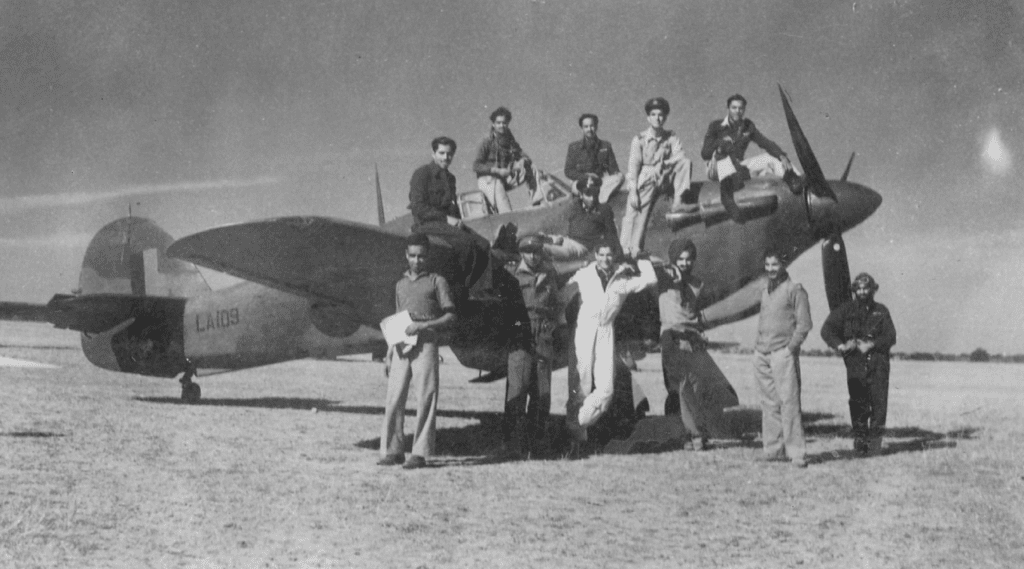
After Asghar Khan moved to Pakistan, he was promoted to the rank of Wing Commander and given charge of Royal Pakistan Air Force College in Risalpur. In 1948, Asghar Khan greeted the founder of Pakistan and Governor-General Muhammad Ali Jinnah when he visited for a passing-out parade. Asghar Khan and all present were deeply moved and influenced by Muhammad Ali Jinnah’s speech wherein he thundered the timeless words “A nation without an air force is at the mercy of any aggressor … second to none.” Impressed heavily by the Father of the nation, Asghar Khan took this advice to heart and went on to accomplish great feats which helped PAF, as well as the nation, to stand staunchly on its feet.
When he was done with his tenure at Risalpur, he was handed over the command of the Fighter Bomber Wing and subsequently, the No. 1 group of PAF in February 1949. In 1950, Asghar Khan became the Director General of the Air Operations (DGAO). After a successful five-year run, he was appointed as the Assistant Chief of the Air Staff in the Air Headquarters, in 1955.
Assuming the Role of Commander-in-Chief
On July 23, 1957, Asghar Khan was promoted to the rank of Air Vice Marshal, thus becoming first native Air Force commander-in-chief at the age of 36. To-date, he has been the youngest to hold that rank. With the vision of the Quaid in mind, Air Marshal Asghar Khan embarked upon a comprehensive strategy to modernise PAF by inducting state-of-the-art aircraft of that time and developing modern infrastructure.
Air Marshal Asghar Khan was a resolute commander and a visionary leader who believed in leading from the front. Being the visionary, he knew the requirements of a potent air force and started to induct modern weapon systems into PAF. There were new developments everywhere. New air bases were being established; the first air defence radar was installed at Badin, and PAF was rapidly setting up its own advanced flying and technical training institutions. New generations of post-independence youth were gaining skills and confidence under their Pakistani squadron and wing leaders. The visionary leadership of Air Marshal Asghar Khan transformed PAF into a modern air force with the induction of new jet fighters, bombers, trainers, transport aircraft, and helicopters. The old fighter squadrons were gradually re-equipped with jet aircraft and many new ones were established. Under the first Pakistani Commander-in-Chief, the modernisation was extended to PAF’s organization and consolidation into a purposefully designed force that could meet new challenges.
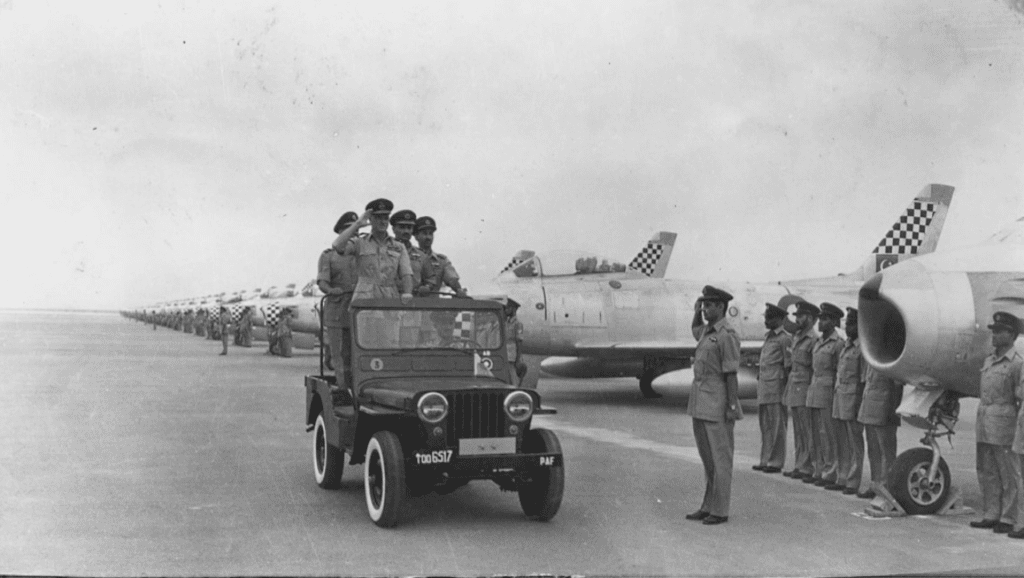
Air Marshal Asghar Khan began a continuing quest for professionalism in all air and ground units and gradually replaced the WW-II styles of command and leadership. He chalked out a comprehensive training program for the pilots of PAF and their training abroad. The engineering, logistic, and administrative officers under a new concept were leading the PAF technicians into delivering unprecedented serviceability rates and efficient management of all resources.
During his command, PAF inducted a wide spectrum of aircraft from USA, which included state-of-the-art F-86 Sabres, T-33 Jet Trainers, T-37 Tweety Birds, B-57 Bombers, formidable F-104 Star Fighters, and ubiquitous C-130 Hercules aircraft. Air Marshal Asghar Khan also launched the fighter training programs and combat courses to train fighter pilots in modern air warfare. He had clearly visualized and laid down the operational doctrine for the nation’s air arm and all its personnel were trained and judged against the highest adoptable professional standards. The gazette report published by the Govt of Pakistan in 1958 highly appreciated the performance of PAF under the able leadership of Air Marshal Asghar Khan. The report revealed that during 1957-8, PAF had the lowest accident rate ever. The report stated “The fact that the service could undertake such a large conversion/induction program with a simultaneous reduction in overall accidents speaks well of the success of PAF”
PAF also emerged as an inspiration in the global arena, as the Common Wealth’s youngest player. One such example was the memorable formation of sixteen F-86 Fighters which performed a loop during an aerial display for King Zahir Shah of Afghanistan in 1958 during his visit to Pakistan. Asghar Khan also formed the Ski and Snow Survival School at Kalabagh in 1960.
Air Marshal Asghar Khan retired from service on the 23rd July, 1965 leaving behind an incomparable legacy.
After Retirement from PAF
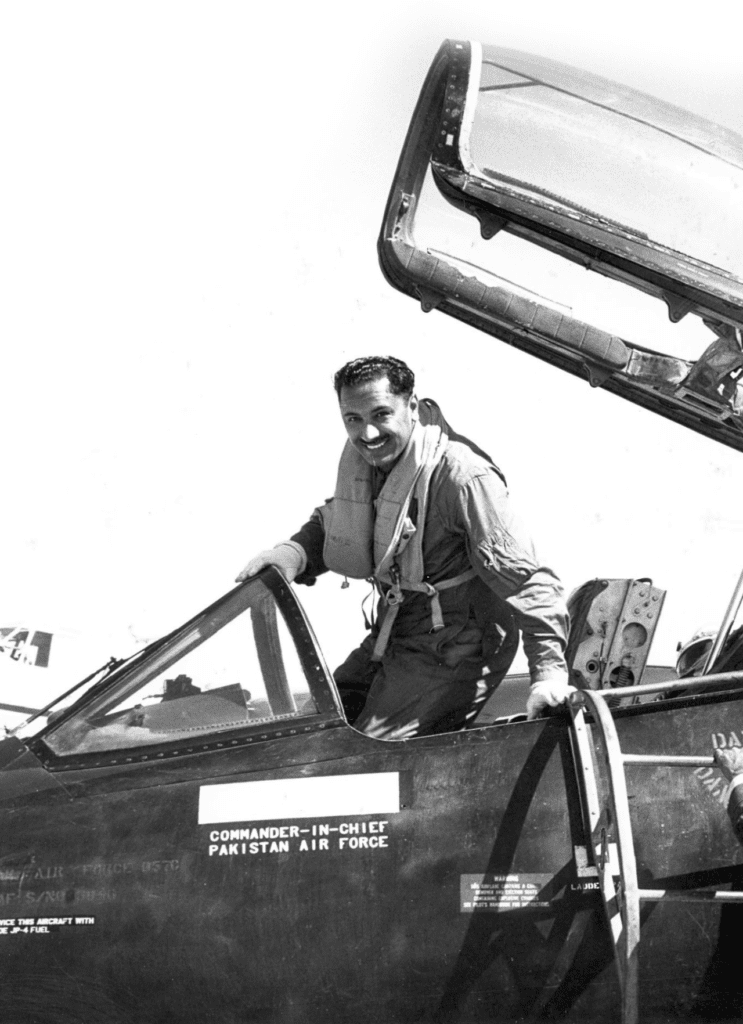
After retiring from the PAF, Asghar Khan was appointed as the President of PIA. During his tenure, PIA implemented high standards of aviation safety and was able to achieve lowest aircraft accident rates. Net profits also soared in his tenure and PIA became a respected competitor in the global air travel business. In addition, Asghar Khan briefly served as the Director-General of the Civil Aviation Authority (CAA). He eventually retired from both his positions in 1968.
It was apparent to all that Asghar Khan had a staunch moral sense. In this spirit, he was a part of multiple political and resistance after his retirement. He fought for what he believed was right, in the face of all odds.
As an Author
Asghar Khan has numerous books to his name. These books have been read widely and accepted as essential reading for any individual interested in delving deeper into state affairs. They remain as relevant today as when they were written.
The Legacy of the Legend
In 1946, Asghar Khan married Amina Shamsie with whom he found marital bliss and would go on to have four children, two daughters and two sons. His eldest son Omar, like his father, was a deeply ambitious and persistent man. He graduated from Cambridge University and went on to become a cabinet minister. Unfortunately, he died at a young age. Asghar Khan’s younger son, Ali Asghar, is a skilled architect by profession who graduated from British Architects, UK. Presently, he is pursuing his career as a politician. Both his daughters are happily married.
The father of PAF passed away at ninety-seven years of age in January 2018 in Islamabad. His funeral was attended by the President of Pakistan, high-ranking officers from armed forces and other government institutions at Nur Khan Air Base. The burial was undertaken his native village Nawanshehr, Abbotabad with full military honors, where a fly-past of K-8 and T-37s from PAF Academy also took place. A year before his demise, PAF Academy was renamed as PAF Academy Asghar Khan, a great honor which he truly deserved.
PAF is fortunate to have a man like Air Marshal Asghar Khan as its founding father. A man of sterling character, humility, outstanding professionalism, and unflinching determination who transformed the nascent air force into a formidable force to be reckoned with. He truly made the PAF, ‘Second to None’ as envisioned by great Quaid decades ago. The entire PAF owes him profusely for the countless contributions he made for this great service; owing to his great achievements, he would truly be regarded as the ‘Father of Pakistan Air Force’ for the times to come.
